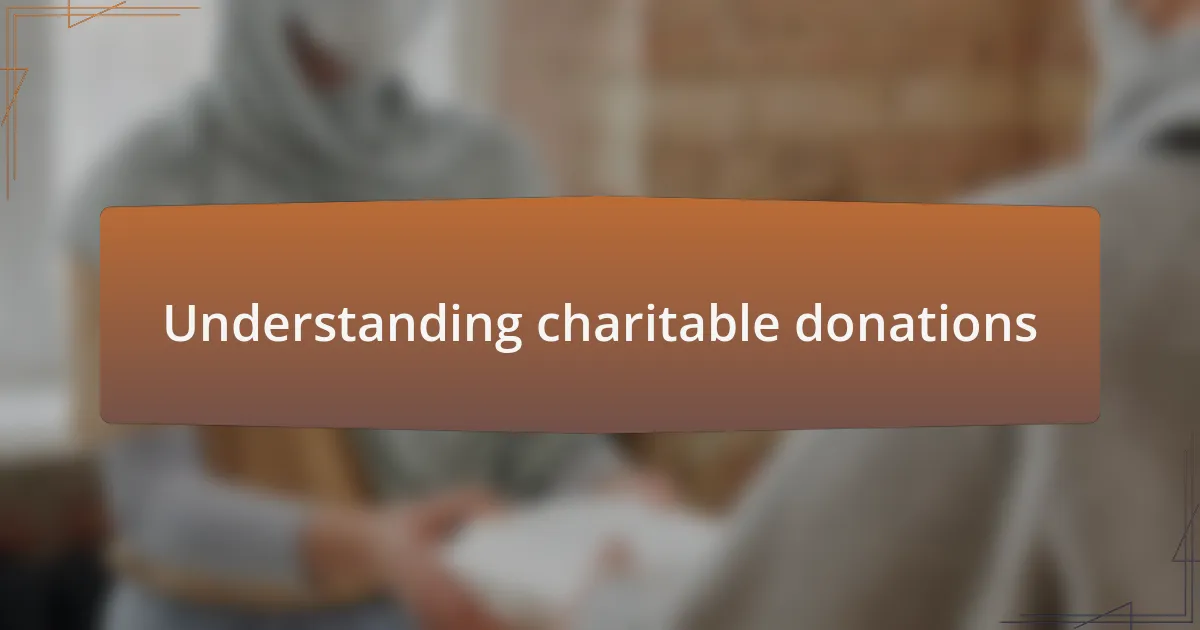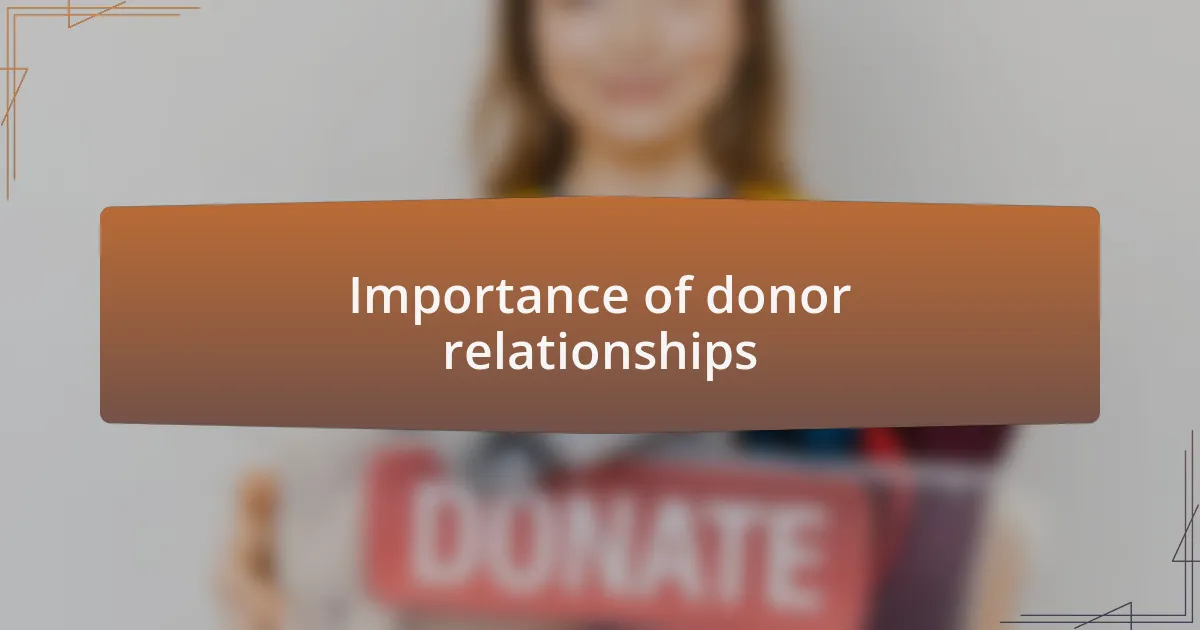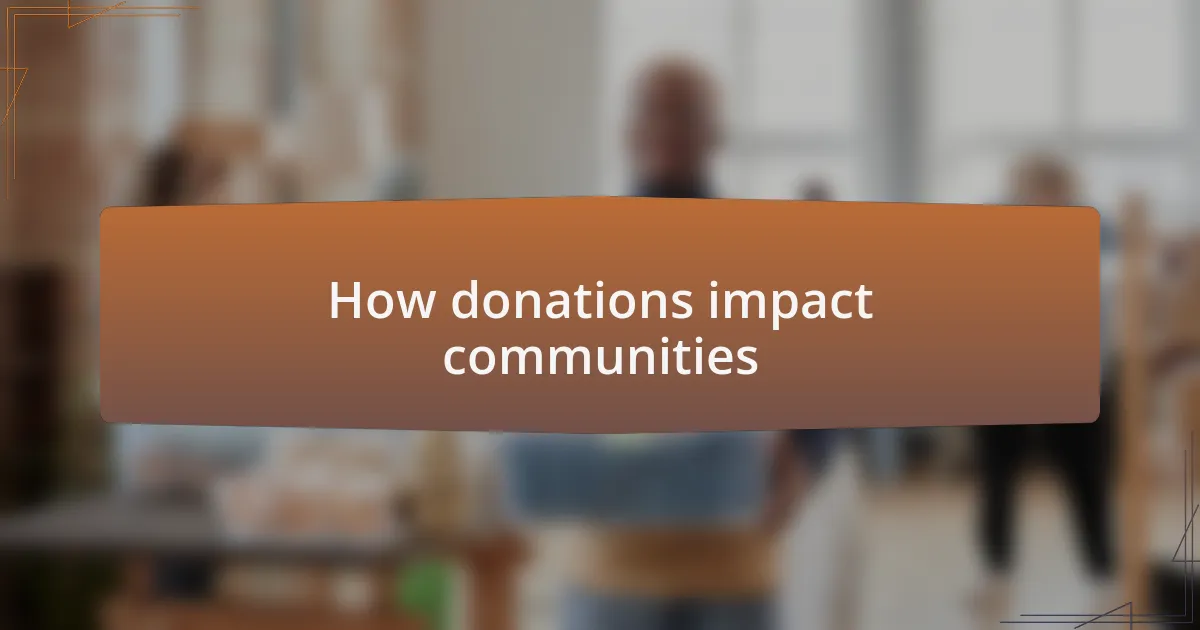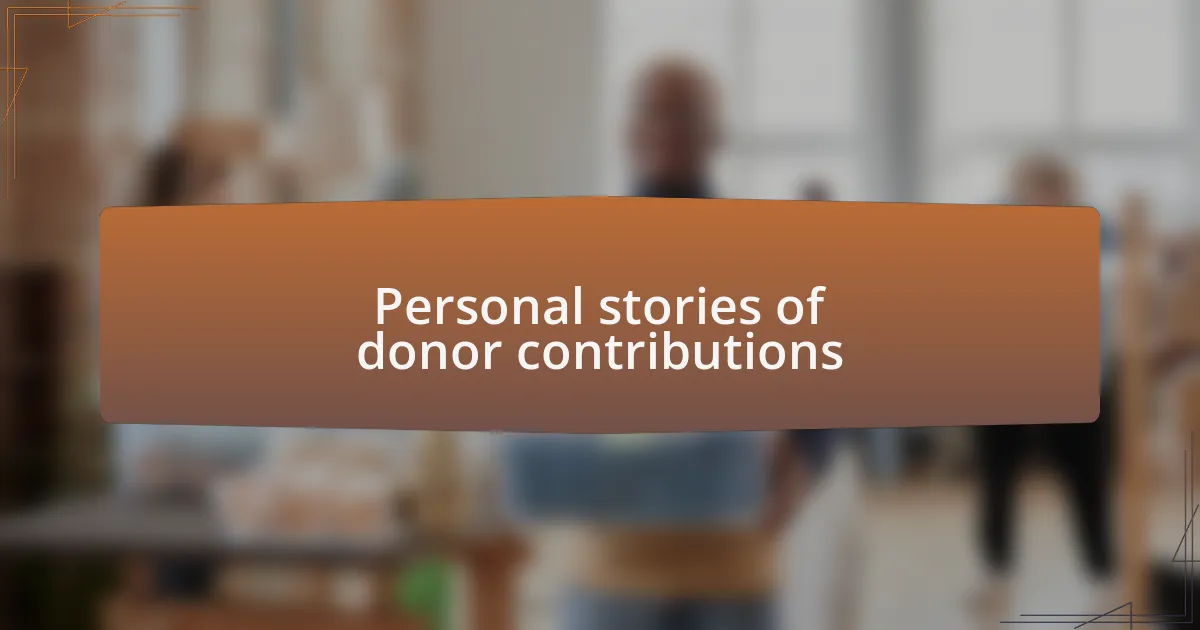Key takeaways:
- Charitable donations connect donors with communities, creating impactful changes and fostering a sense of belonging and purpose.
- Building strong relationships with donors is essential for organizational sustainability, encouraging continued support and engagement.
- Donations can significantly alter community dynamics, empowering individuals and creating positive ripple effects that benefit everyone.
- Personal stories of donor contributions highlight the emotional connections and transformative power of generosity, inspiring ongoing commitment and action.

Understanding charitable donations
Charitable donations are often rooted in the desire to make a positive impact on the world. I remember when I first decided to contribute to a local food bank; the thought of helping families in need truly resonated with me. It wasn’t just about giving money; it was about connecting with a community and realizing that each contribution—no matter how small—can spark change.
When I think of donations, I see them as a bridge connecting generous hearts to those in need. Have you ever considered how a simple act of kindness can unfold into a lifeline for someone? It’s incredible to think that your donation might help provide shelter for a homeless family or meals for children who might otherwise go hungry. These are not just statistics; they represent real lives that can be impacted profoundly.
The motivations behind charitable giving can vary, from personal experiences to a sense of duty. For instance, I often reflect on how witnessing a friend’s struggles due to illness compelled me to support medical research initiatives. The emotional depth of giving often transforms the donor, creating a sense of purpose that goes beyond the financial aspect. It’s a powerful reminder that our contributions serve as proof that we care, and that’s a thread that binds us all together in humanity.

Importance of donor relationships
Building strong relationships with donors is essential for the sustainability of any charitable organization. I recall a time when I reached out to a donor who had given consistently over the years. During our conversation, I learned that their motivation stemmed from a childhood experience of scarcity. Understanding this not only deepened my respect for their contributions but also helped me express genuine gratitude, reinforcing their commitment to our cause.
Donor relationships are not just transactional; they are about fostering a sense of community and belonging. I often wonder how many organizations miss the opportunity to connect with their supporters on a personal level. Engaging with donors through personalized updates and heartfelt stories can transform their experience from mere donors to valued partners in the mission. When they see the direct impact of their gifts, it cultivates an emotional bond that encourages continued support.
Moreover, nurturing these relationships can lead to invaluable insights. I’ve found that regular communication opens channels for feedback, allowing donors to feel heard and involved. Have you ever considered how powerful it is to ask your donors what they wish to see change? This level of engagement not only drives loyalty but also helps shape the organization’s future growth and direction, ultimately enhancing the impact we can make together.

How donations impact communities
Donations can fundamentally alter the landscape of communities in ways that often go unnoticed. I remember a small neighborhood that transformed after a local organization used funds to create a community garden. Watching families come together to plant flowers and vegetables not only improved the area’s aesthetics but also fostered relationships between people who had lived side by side but never interacted. Isn’t it remarkable how a small act of giving can lead to such profound social change?
Moreover, the ripple effect of donations extends beyond immediate beneficiaries. For instance, when a local charity receives support for its after-school programs, it doesn’t just help the children who attend; it also uplifts the entire community by reducing crime rates and improving educational outcomes. I’ve seen parents gain confidence knowing their children are engaged in positive activities. Doesn’t it make you think about the broader implications of each donation and how they can create healthier, safer environments?
Another striking aspect is how donations can empower individuals. I once met a scholarship recipient who shared her story about how financial support allowed her to attend college. She became a community leader, inspiring others to pursue their dreams. This instills hope and motivates others to contribute, creating a cycle of giving and improvement. Have you ever imagined how one gift can spark a chain reaction that uplifts the entire community? It’s a beautiful testament to the transformative power of generosity.

Personal stories of donor contributions
Personal stories of donor contributions often resonate on a very personal level. I recall a heartfelt encounter with a donor who shared their journey of losing a loved one to illness. In memory of that person, they chose to fund a local health initiative, which not only provided essential services but also created a support network for others grappling with similar experiences. Hearing how their grief transformed into action was nothing short of inspiring.
Thinking about the connections forged through these contributions, I vividly remember a family who decided to sponsor a mentorship program for at-risk youth. They not only provided financial support but also took the time to volunteer, sharing their skills and experiences. One day, a young participant expressed that this was the first time someone believed in him. That moment struck me deeply—how much difference one family’s commitment can make in a young person’s life. Doesn’t it make you reflect on the profound impact we can have on each other’s futures?
Another poignant example that comes to mind involves a donor who funded art supplies for a community center. During the unveiling of a mural created by local youth, I witnessed a burst of pride and joy in their eyes. These young artists had transformed their emotions and stories into vibrant visual expressions. The donor was overwhelmed with gratitude, realizing the immensity of the change they facilitated. How often do we pause to recognize the lives touched through our contributions? Each story is a reminder of the unique ways we can uplift others through our actions.

Building long-term donor engagement
Understanding how to build long-term engagement with donors is crucial for any charitable organization. In my experience, maintaining open lines of communication helps create a sense of belonging for donors. For example, I once attended a small gathering where donors were given a platform to share their thoughts and experiences. The conversations that emerged were not only heartfelt but also fostered deeper relationships between the donors and the cause.
I’ve also seen the power of expressing gratitude through personalized messages. After a significant gift, I took the time to write a handwritten note to the donor, acknowledging their impact. Their response was overwhelming—a simple thank you evolved into an ongoing dialogue about their vision for philanthropy. It made me realize that genuine appreciation can ignite a more profound commitment. When was the last time you felt truly valued in a collaboration or partnership?
Donor engagement thrives when organizations provide updates on the impact of contributions. In a recent newsletter, I highlighted stories of individuals benefiting from a specific program funded by donors. The excitement and satisfaction from those donors when they learned how their support brought about tangible change were palpable. It reinforced how vital it is to illustrate the real-world effects of their generosity—after all, don’t we all want to see the fruits of our efforts?